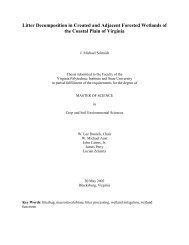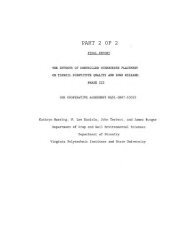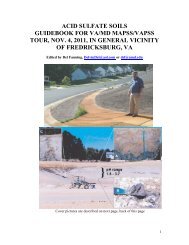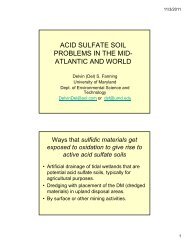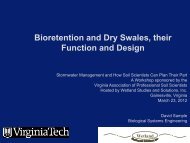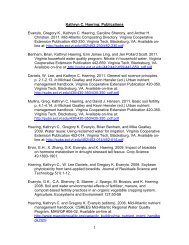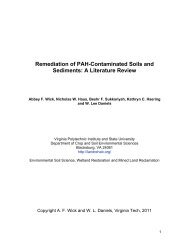Daniels and Orndorff, 2003 ICARD Acid Rock Drainage
Daniels and Orndorff, 2003 ICARD Acid Rock Drainage
Daniels and Orndorff, 2003 ICARD Acid Rock Drainage
You also want an ePaper? Increase the reach of your titles
YUMPU automatically turns print PDFs into web optimized ePapers that Google loves.
<strong>Acid</strong> <strong>Rock</strong> <strong>Drainage</strong> From Highway <strong>and</strong> Construction Activities<br />
in Virginia, USA<br />
W L <strong>Daniels</strong> 1 <strong>and</strong> Z W <strong>Orndorff</strong> 2<br />
ABSTRACT<br />
Excavation through sulfidic geologic materials during construction<br />
activities has resulted in acid rock drainage (ARD) related problems at<br />
numerous (>40) locations across all five geologic regions of Virginia,<br />
USA. Potential acidities ranging from >100 to
W L DANIELS <strong>and</strong> Z W ORNDORFF<br />
early-1980s included capping of the waste rock pile with clay<br />
<strong>and</strong> topsoil, a water treatment facility, wetl<strong>and</strong>s, <strong>and</strong> other<br />
experimental techniques. Initial remediation costs exceeded over<br />
two million dollars, with operation <strong>and</strong> maintenance costing<br />
about $US 240 000 annually since 1982. Nonetheless, acid<br />
drainage from the airport <strong>and</strong> associated sites continues to be a<br />
problem (Zentilli <strong>and</strong> Fox, 1997; Fox, Robinson <strong>and</strong> Zentilli,<br />
1997; Hicks, <strong>2003</strong>).<br />
Perhaps the most critical step in characterising <strong>and</strong> managing<br />
sulfidic materials is the development <strong>and</strong> testing of accurate<br />
techniques for screening the acid-forming potential of geologic<br />
materials. Extensive research has been conducted on this topic<br />
over the past 30 years in various mining environments (Sobek,<br />
Skousen <strong>and</strong> Fisher, 2000; Geidel <strong>and</strong> Caruccio, 2000), however,<br />
the application of these same procedures to the diverse range of<br />
sulfidic materials likely encountered in statewide road building<br />
programs has not been documented.<br />
METHODS AND MATERIALS<br />
In the fall of 1997, a questionnaire regarding occurrence <strong>and</strong><br />
locations of acid roadcuts was distributed to all of the Virginia<br />
Department of Transportation (VDOT) districts. All sites<br />
reported (n = 27) as a result of this questionnaire were visited<br />
over the following year. Over 20 additional sites were reported<br />
later or discovered independently. Geologic materials <strong>and</strong> road<br />
drainage grab samples, where available, were collected from all<br />
sites. Both fresh <strong>and</strong> weathered representative samples of<br />
lithologies at each site were obtained. The geologic formations<br />
<strong>and</strong> specific rock types at all sites were determined through field<br />
observations, personal communications with state geologists, <strong>and</strong><br />
geologic maps. All geologic samples were tested for potential<br />
peroxide acidity (PPA) using the H2O2 oxidation/titration method<br />
of Barnhisel <strong>and</strong> Harrison (1976) which is a variation of the<br />
method described by O’Shay, Hossner <strong>and</strong> Dixon, (1990).<br />
Total-S was determined with an Elementar Vario Max CNS<br />
analyser, <strong>and</strong> rated for presence of carbonates by the HCl ‘fizz<br />
test’ (Sobek et al, 1978), <strong>and</strong> pH in H2O <strong>and</strong> KCl using a<br />
combination electrode. Surface samples from rock exposures that<br />
contained a sufficient amount of soil-sized particles (0.2 per cent) were found at all locations indicating that S<br />
occurrence may be ubiquitous in the Chesapeake Group.<br />
Sediments containing carbonates have lower PPA values,<br />
generally ranging from 0 - 20 Mg CaCO3/1000 Mg material, <strong>and</strong><br />
were found in only few samples from deep borings <strong>and</strong> not in<br />
acid road banks. This suggests one of the following:<br />
1. carbonate-bearing layers in the Tertiary marine sediments<br />
tend to occur at greater depths;<br />
2. excavation through carbonate-bearing sediments does not<br />
result in severe ARD; or<br />
3. carbonates have been leached out of existing roadcuts by<br />
acid drainage.<br />
480 Cairns, QLD, 12 - 18 July <strong>2003</strong> 6th <strong>ICARD</strong>
ACID ROCK DRAINAGE FROM HIGHWAY AND CONSTRUCTION ACTIVITIES IN VIRGINIA, USA<br />
TABLE 1<br />
Summary of potential peroxide acidity (PPA) <strong>and</strong> per cent total-S levels for geologic samples, <strong>and</strong> pH <strong>and</strong> metal content of a road drainage<br />
sample from representative sites. Note: The Appalachian Plateau Province was not specifically sampled by <strong>Orndorff</strong> (2001) <strong>and</strong> therefore<br />
data are not presented here.<br />
Geologic formation (Region) Sample size Geologic samples Representative surface water drainage samples<br />
PPA † %S pH Fe Al Mn<br />
Dissolved – mg/L<br />
Zn S<br />
Tabb Formation (Coastal Plain) n = 10 3.2 0.1 3.05 12.4 15.2 2.4 0.6 136<br />
Tertiary Marine Sediments (Coastal Plain) n = 49 20.9 0.79 3.09 13.9 49.5 2.1
W L DANIELS <strong>and</strong> Z W ORNDORFF<br />
Upon exposure, sulfide oxidation causes pH to decrease rapidly.<br />
Weathered materials at the surface of roadcuts through the<br />
Chesapeake Group <strong>and</strong> Lower Tertiary deposits typically appear<br />
yellowish-brown, have pH values between 2.5 - 3.5, have PPA<br />
values between 10 - 20 Mg CaCO 3/1000 Mg material, <strong>and</strong> retain<br />
less than one per cent S. Less oxidised, underlying grey sediments<br />
have slightly higher pH values <strong>and</strong> much higher PPA values,<br />
ranging from about 30 - 50 Mg CaCO 3/1000 Mg material.<br />
<strong>Acid</strong> sulfate weathering problems were less severe at a few<br />
sites that are surficially mapped as the Sedgefield member of the<br />
Pleistocene aged Tabb formation. The Sedgefield member<br />
consists of fossiliferous brackish-bay s<strong>and</strong>, beach <strong>and</strong> near-shore<br />
marine clayey s<strong>and</strong>, <strong>and</strong> lagoonal <strong>and</strong> marsh clay <strong>and</strong> clayey<br />
s<strong>and</strong>. In our experience, materials with PPA values below 10 Mg<br />
CaCO 3/1000 Mg are readily reclaimed with proper management,<br />
while materials with PPA values between 10 - 60 require intense<br />
reclamation management (<strong>Daniels</strong>, Li <strong>and</strong> Stewart, 2000).<br />
Considering these guidelines, <strong>and</strong> the widespread occurrence of<br />
S through the Chesapeake Group <strong>and</strong> Lower Tertiary deposits,<br />
exposure of Tertiary marine sediments may be considered highly<br />
likely to produce problematic roadside management conditions<br />
which require intense reclamation efforts. Exposure of the<br />
Sedgefield member of the Tabb formation may be considered<br />
likely to produce moderately problematic roadside vegetation<br />
management conditions, which could require special reclamation<br />
efforts.<br />
Piedmont Province<br />
<strong>Acid</strong> roadcuts in Stafford County in Northern Virginia occur in<br />
pyritic phyllite <strong>and</strong> slate of the Quantico Formation. Reflected<br />
light microscopy of polished sections revealed the presence of<br />
pyrite as corroded subhedral <strong>and</strong> euhedral grains, along with<br />
chalcopyrite <strong>and</strong> covellite. Microcrystalline forms, such as those<br />
described for Coastal Plain sediments, were not observed. The<br />
PPA values for surface samples ranged from 6 - 22 Mg CaCO 3/<br />
1000 Mg material, <strong>and</strong> S values ranged from 0.24 - 1.00 per cent.<br />
One sample from relatively unweathered underlying material had<br />
a significantly higher PPA value, 99 Mg CaCO 3/1000 Mg<br />
material, <strong>and</strong> contained over 3.8 per cent S. Previous analysis of<br />
six phyllite samples collected by VDOT in Stafford revealed PPA<br />
values ranging from 1 - 85 Mg CaCO 3/1000 Mg material. These<br />
values indicate sulfides are unevenly distributed throughout the<br />
roadcut; however, more detailed sampling would be necessary to<br />
characterise this spatial variability.<br />
Compared to sulfidic sediments of the Coastal Plain, sulfide<br />
levels in the Quantico Formation appear to be more variable <strong>and</strong><br />
occur over a much larger range of S values. With one exception,<br />
drainage from this site had lower EC, <strong>and</strong> higher acidity <strong>and</strong><br />
metal concentrations, than any other evaluated roadcut. Exposure<br />
of the Quantico Formation may be considered highly likely to<br />
produce severely problematic roadside management conditions,<br />
which require intense reclamation efforts. Roadcut surfaces of<br />
the Quantico Formation may be quite steep <strong>and</strong> generally consist<br />
of shallow, rocky, weathered material over bedrock, <strong>and</strong> rock<br />
outcrops, which are less suited for st<strong>and</strong>ard soil remediation<br />
methods than the unconsolidated sediments of the Coastal Plain.<br />
Similar detailed information on acid-forming materials <strong>and</strong><br />
associated soil, water quality <strong>and</strong> engineered materials affects in<br />
the other regions of Virginia can be found in <strong>Orndorff</strong> (2001) <strong>and</strong><br />
<strong>Orndorff</strong> <strong>and</strong> <strong>Daniels</strong> (2002). These reports also contain a full list<br />
of all cited studies of sulfidic geologic <strong>and</strong> mine waste materials<br />
in all five geologic provinces of Virginia.<br />
Final compilation of a statewide sulfide hazard<br />
rating map<br />
The impact of acid drainage resulting from the exposure of<br />
sulfidic materials during road construction depends on many<br />
variables, including the relative volume of ARD moving to<br />
surface stream flow, the flow rate of local surface waters, <strong>and</strong> the<br />
neutralising capacity of surrounding geologic materials.<br />
Although materials may be rated based on characteristics related<br />
to S content, PPA, <strong>and</strong> rock drainage quality, the true risk of<br />
environmental impact will depend on site-specific conditions.<br />
With this in mind, the following scheme was developed to assess<br />
geologic materials with general ratings in terms of sulfide<br />
hazard. Materials were placed into four risk screening classes<br />
based on PPA <strong>and</strong> total-S values:<br />
1. materials for which 90 per cent of samples tested less than<br />
10 Mg CaCO3/1000 Mg material <strong>and</strong> contained less than<br />
0.5 per cent S;<br />
2. materials for which 90 per cent of samples tested less than<br />
10 Mg CaCO3/1000 Mg material <strong>and</strong> more than ten per<br />
cent of the samples tested greater than 0.5 per cent S;<br />
3. materials for which more than ten per cent of samples<br />
tested greater than 10 Mg CaCO3/1000 Mg material <strong>and</strong><br />
less than ten per cent of samples tested greater than 60 Mg<br />
CaCO3/1000 Mg material; <strong>and</strong><br />
4. materials for which more than ten per cent of the samples<br />
tested greater than 60 Mg CaCO3/1000 Mg material.<br />
These class boundaries were determined with consideration of<br />
st<strong>and</strong>ard remediation methods <strong>and</strong> the observed properties of a<br />
wide range of sulfidic materials. Application of these ratings to<br />
the range of geologic materials evaluated in this study is shown<br />
in Table 2. Again it should be emphasised that these ratings are<br />
based strictly on the acid-producing potential of a particular<br />
material, whereas actual acid production <strong>and</strong> severity of impact<br />
will depend on site conditions. The overall distribution of all<br />
scientifically documented acid-producing strata in the eastern<br />
portion of Virginia is presented in Figure 2, which is a detailed<br />
portion of the full statewide risk map produced by this study.<br />
TABLE 2<br />
Sulfide hazard rating for evaluated geologic materials.<br />
Geologic map unit Sulfide hazard<br />
rating †<br />
Tabb formation – Sedgefield Member<br />
(Coastal Plain)<br />
1<br />
Wise, Kanawha, Norton, New River, Lee <strong>and</strong><br />
Pocahontas Formations (Appalachian Plateau)<br />
1<br />
Ashe Formation of the Lynchburg Group<br />
(Blue Ridge)<br />
2<br />
Chesapeake Group (Coastal Plain) 3<br />
Lower Tertiary deposits (Coastal Plain) 3<br />
Marcellus shale <strong>and</strong> Needmore Formation<br />
(Ridge <strong>and</strong> Valley)<br />
3<br />
Millboro shale <strong>and</strong> Needmore Formation<br />
(Ridge <strong>and</strong> Valley)<br />
3<br />
Quantico Formation (Piedmont) 4<br />
Chattanooga Shale (Ridge <strong>and</strong> Valley) 4<br />
† 1 = least severe, 4 = most severe.<br />
482 Cairns, QLD, 12 - 18 July <strong>2003</strong> 6th <strong>ICARD</strong>
Stafford airport case study<br />
The Stafford regional airport site (see Figure 3) occurs directly<br />
between two of the locations that were sampled <strong>and</strong> documented<br />
in the VDOT corridor study described above. However, we were<br />
unaware of its existence until 2001 due to a lack of direct VDOT<br />
involvement in the construction <strong>and</strong> monitoring of the project.<br />
This particular location was only reported to us after multiple<br />
conventional revegetation efforts failed, <strong>and</strong> we were referred by<br />
Virginia regulatory agency personnel. To our knowledge, this is<br />
the largest single exposure of acid forming materials in the<br />
eastern USA to date, other than that which occurred in the<br />
unregulated era of Appalachian coal mining (pre-1977).<br />
Construction activities at the site between 1998 <strong>and</strong> 2001<br />
disturbed over 150 ha of lower Tertiary Coastal Plain materials as<br />
the airport runway was constructed through a deeply dissected<br />
l<strong>and</strong>scape. As construction proceeded, long spur ridges were<br />
excavated to depths ≥25 m, exposing significant volumes of grey,<br />
reduced, sulfidic (0.6 to 1.2 per cent pyritic-S) silty sediments<br />
which were subsequently filled into intervening valley fills to<br />
ACID ROCK DRAINAGE FROM HIGHWAY AND CONSTRUCTION ACTIVITIES IN VIRGINIA, USA<br />
FIG 2 - Geographic extent of sulfide-bearing geologic materials in the Coastal Plain of Virginia, USA.<br />
support the >1500 m runway. Excavated sulfidic materials<br />
exceeded the capacity of the valley fills <strong>and</strong> were also placed<br />
into several large, steeply sloping excess spoil fills along a<br />
first-order stream draining the eastern section of the site (see<br />
Figure 3). Due to the fact that the sulfidic nature of these<br />
materials was not recognised until well after all final grading was<br />
completed, the acid-forming materials were not isolated away<br />
from drainage, <strong>and</strong> in fact were essentially scattered r<strong>and</strong>omly,<br />
<strong>and</strong> thoroughly, throughout the site.<br />
Soil acidity <strong>and</strong> associated site conditions<br />
Inspection of the 10 to 15 m deep cut faces left uncovered along<br />
the northern margin of the site in November 2001 revealed that<br />
the upper 5 to 8 m of the soil-geologic column was pre-oxidised<br />
by long term natural weathering processes, supported a soil pH<br />
of 4.1 to 4.5, <strong>and</strong> was well-vegetated. However, below this<br />
pre-oxidised depth, the soil pH in the weathered cut faces ranged<br />
from 3.5 to 1.8, with prominent white salt efflorescences.<br />
Fanning, Coppock <strong>and</strong> Rabenhorst (2002) also confirmed<br />
6th <strong>ICARD</strong> Cairns, QLD, 12 - 18 July <strong>2003</strong> 483
W L DANIELS <strong>and</strong> Z W ORNDORFF<br />
occurrence of active acid-sulfate soil conditions on site. The<br />
slopes were barren of vegetation <strong>and</strong> prominent acid rock<br />
drainage was present. Concrete lined drainage ditches <strong>and</strong><br />
culverts were coated in iron <strong>and</strong> significant etching <strong>and</strong><br />
degradation of the cement components were noted. Galvanised<br />
steel st<strong>and</strong>pipes in water control structures in stormwater basins<br />
below the site had also been completely degraded by the<br />
drainage over time, releasing large volumes of sulfidic sediments<br />
into the receiving floodplain. As discussed below, the acid<br />
drainage from this site had seriously degraded surface water both<br />
on- <strong>and</strong> off-site.<br />
In December 2001, the existing surface soils were composite<br />
sampled from 42 different locations across the site in association<br />
with soil mapping requirements for remedial treatment. These<br />
samples were analysed for soil:water pH <strong>and</strong> PPA as described<br />
earlier. Soil pH ranged from a low of 1.80 to high of 5.28 with an<br />
average of pH 3.05. Potential acidities ranged from -0.6 to -41.8<br />
Mg calcium carbonate equivalence (CCE) per thous<strong>and</strong> Mg<br />
material, with an average presumed lime requirement of 9.6 parts<br />
per thous<strong>and</strong> or 21.5 Mg CCE per ha to an incorporation depth of<br />
15 cm. It was clear from site mapping <strong>and</strong> detailed field<br />
inspection that a few fill cells <strong>and</strong> surfaces at the airport site<br />
received only minimal inputs of sulfidic materials. These areas<br />
generally supported vegetation, were reddish to yellowish brown<br />
in soil colour, <strong>and</strong> had soil pH values >3.8. However, the vast<br />
majority of the site was completely barren of vegetation, was<br />
characterised by grey (low chroma) soil colours, <strong>and</strong> soil pH<br />
Location Date pH EC<br />
(uS/cm)<br />
SW 4<br />
(Above site)<br />
SW 1<br />
(In site)<br />
SW 6<br />
(Below site)<br />
Due to the naturally acidic nature of the soils within this<br />
watershed, background surface water pH was typically less than<br />
5.5, with moderate levels of dissolved Fe (Table 3). In general,<br />
water quality discharging from the airport <strong>and</strong> from the NRCS<br />
impoundment in early-2002 was highly acidified (pH 3.3 to 3.5)<br />
<strong>and</strong> high in dissolved Fe, Mn, Al <strong>and</strong> S. Based upon comparison<br />
with data from SW 7 <strong>and</strong> other control locations (data not<br />
shown), there is no doubt that the airport construction had<br />
significant negative water quality effects on Potomac Creek, <strong>and</strong><br />
upon an undetermined reach of the stream below the dam<br />
discharge point due to the acidity <strong>and</strong> metals released over time.<br />
Water samples taken subsequent to application of lime-stabilised<br />
biosolids indicated that the pH of water discharging from the<br />
on-site stormwater detention basins (eg SW 6) <strong>and</strong> the NRCS<br />
floodwater structure sequentially increased into the 6’s <strong>and</strong> low<br />
7’s, but then declined again somewhat by November, 2002.<br />
Dissolved Fe in discharge waters ranged from 10 to 40 mg/L, <strong>and</strong><br />
ranged from 4 to 9 mg/L in early-2002 samples from the NRCS<br />
Dam. By early June, however, the pH at the NRCS Dam was 7.3<br />
with much lowered levels of metals. Sulfur levels remained<br />
elevated, however, presumably due to the long-term release of<br />
sulfate accumulated from the pyrite weathering reactions<br />
associated with the site. However, our past experience in<br />
coalfield acid mine drainage dynamics (<strong>Daniels</strong>, Li <strong>and</strong> Stewart,<br />
2000) has indicated that seasonal (fall/winter) flushes of acid<br />
reaction products from acid forming materials are possible.<br />
Therefore, we cannot reach any firm conclusions regarding the<br />
long-term effects of the lime-stabilised biosolids on site run-off<br />
acidity <strong>and</strong> metal levels at this time.<br />
Nitrate-N in all internal <strong>and</strong> discharge surface water samples<br />
was low through August of 2002, ranging from
W L DANIELS <strong>and</strong> Z W ORNDORFF<br />
draining a much larger watershed to pH 0.2 per cent) in all future road corridors<br />
passing through known risk zones.<br />
Once potentially acidic materials are exposed in cuts <strong>and</strong><br />
disposed of in oxidised fill environments (unsaturated), the<br />
thermodynamics of pyrite oxidation will inevitably lead to acid<br />
generation. In extreme examples, such as those found at the<br />
Stafford airport, widespread soil <strong>and</strong> surface water acidification<br />
<strong>and</strong> associated environmental damage will ensue. Currently, the<br />
only known proven technique for permanently remediating these<br />
situations is to bulk-blend lime or other alkaline materials with<br />
the cut surface, or with the bulk of the disposal fill based upon<br />
appropriate acid-base accounting procedures. Where feasible,<br />
placement of the sulfidic materials below the:<br />
1. water table; or<br />
2 beneath an impermeable engineered cap will also<br />
drastically limit or prevent acid generation.<br />
Obviously, avoidance of sulfidic materials in the road planning<br />
process is clearly the preferred mitigation alternative. However, it<br />
is obvious that in many instances:<br />
1. road corridors or construction projects cannot be<br />
economically relocated sufficiently to miss sulfide-bearing<br />
strata; <strong>and</strong><br />
2. the increasing depth of cut in modern road designs in<br />
rolling topography will lead to increased probability of<br />
intercepting sulfidic materials.<br />
While the barren <strong>and</strong> erosive slopes resulting from<br />
acidification of cut roadbanks are the most obvious indicator of<br />
this problem, the long term emission of acidic drainage from fills<br />
is clearly the most serious environmental compliance problem<br />
that VDOT <strong>and</strong> other l<strong>and</strong> developers will face with sulfidic<br />
materials over time. It is clear that acid seepage from fills is<br />
causing local damage to Virginia’s streams at various locations.<br />
While the extent of this damage is very localised <strong>and</strong> not<br />
extensive to date, the costs of capturing <strong>and</strong> treating these<br />
discharges could represent significant long-term costs if <strong>and</strong><br />
when they are identified as point source discharges. Therefore,<br />
the true cost of identifying, h<strong>and</strong>ling <strong>and</strong> disposing of potentially<br />
acid-forming materials must be rigorously assessed <strong>and</strong> designed<br />
for in the overall construction process.<br />
ACKNOWLEDGEMENTS<br />
We are indebted to the Virginia Transportation Research Council<br />
(Mike Fitch <strong>and</strong> Mike Perfater) <strong>and</strong> to the District of Columbia<br />
Water <strong>and</strong> Sewer Authority (Chris Peot) for their support of<br />
various components of the work reported here. We also<br />
appreciate the field support of Wright Trucking Inc. (Lloyd <strong>and</strong><br />
Milton Wright), Synagro (Steve McMahon), Adam Crist with<br />
Stafford County, <strong>and</strong> the collective efforts of Campbell <strong>and</strong> Paris<br />
(Tim Harms, Tony DiLuca, Cindi Martin <strong>and</strong> Ed Wallis) at<br />
Stafford airport. Thanks also to Pat Donovan <strong>and</strong> Katie Haering<br />
of Virginia Tech for assistance on the Stafford airport project.<br />
Finally, we greatly appreciate the long-term persistence of Dr<br />
Delvin Fanning of the University of Maryl<strong>and</strong> in pointing out the<br />
nature of acid-sulfate soils to our colleagues around the world.<br />
REFERENCES<br />
Adams, C B, Klamke C A <strong>and</strong> Hollabaugh, C L, 1999. Geochemical<br />
monitoring of Kiser Creek, near Buchanan, Harallson County,<br />
Georgia: the effects of pyrite-rich rocks on the pH, iron, <strong>and</strong> sulfate<br />
content of surface waters, Georgia Journal of Science,<br />
57(2):113-122.<br />
Anderson, R, Bell B <strong>and</strong> Reynolds, J, 1991. Induced polarization used for<br />
highway planning, Investigations in Geophysics, 4:397-410.<br />
Barnhisel, R I <strong>and</strong> Harrison, J, 1976. Estimating lime requirement by a<br />
modified hydrogen peroxide potential acidity method, Kentucky<br />
Agric Exper Sta, Soil Testing Laboratory, Lexington, KY, USA.<br />
486 Cairns, QLD, 12 - 18 July <strong>2003</strong> 6th <strong>ICARD</strong>
<strong>Daniels</strong>, W L <strong>and</strong> Stewart, B R, 2000. Reclamation of Appalachian coal<br />
refuse disposal areas, in Reclamation of Drastically Disturbed L<strong>and</strong>s<br />
(Eds: R I Barnhisel, R G Darmody <strong>and</strong> W L <strong>Daniels</strong>), Monograph<br />
41, pp 433-460 (American Society of Agronomy: Madison).<br />
<strong>Daniels</strong>, W L, Li, R S <strong>and</strong> Stewart, B R, 2000. Influence of liming <strong>and</strong><br />
topsoil on vegetative growth <strong>and</strong> leaching potentials of acid coal<br />
refuse, Transactions, Soc Mining Metallurgy <strong>and</strong> Explor, 308:25-31.<br />
<strong>Daniels</strong>, W L, Evanylo, G K, Nagle, S M <strong>and</strong> Schmidt, J M, 2001.<br />
Effects of biosolids loading rate <strong>and</strong> sawdust additions on row crop<br />
yield <strong>and</strong> nitrate leaching potentials in Virginia s<strong>and</strong> <strong>and</strong> gravel mine<br />
reclamation, in Proceedings 2001 National Meeting of the American<br />
Society of Mining <strong>and</strong> Reclamation, pp 399-406 (ASMR, 3134<br />
Montavesta Rd, Lexington, KY, USA, 40502).<br />
<strong>Daniels</strong>, W L, Nagle, S M, Whittecar, G R <strong>and</strong> Evanylo, G K, 2002.<br />
Effects of biosolids application on ground water nitrate-N levels in<br />
s<strong>and</strong> <strong>and</strong> gravel mine reclamation in Virginia, in Proceedings 2002<br />
National Meeting of the American Society of Mining <strong>and</strong><br />
Reclamation, pp 645-674 (ASMR, 3134 Montavesta Rd, Lexington,<br />
KY, USA, 40502).<br />
Fanning, D S, Coppock, C <strong>and</strong> Rabenhorst, M C, 2002. Upl<strong>and</strong> active<br />
acid sulfate soils from construction of new Stafford County, Virginia,<br />
USA, in Conference Abstracts, Fifth International <strong>Acid</strong> Sulfate Soils<br />
Conference, p 126 (Tweed Heads: NSW Australia).<br />
Fox, D, Robinson, C <strong>and</strong> Zentilli, M, 1997. Pyrrhotite <strong>and</strong> associated<br />
sulphides <strong>and</strong> their relationship to acid rock drainage in the Halifax<br />
Formation, Meguma Group, Nova Scotia, Atlantic Geology,<br />
33:87-103.<br />
Geidel, G <strong>and</strong> Caruccio, F T, 2000. Geochemical factors affecting coal<br />
mine drainage quality, in Reclamation of Drastically Disturbed<br />
L<strong>and</strong>s (Eds: R I Barnhisel, R G Darmody <strong>and</strong> W L <strong>Daniels</strong>)<br />
Monograph 41, pp 105-130 (American Society of Agronomy:<br />
Madison).<br />
Huckabee, J W, Goodyear, C <strong>and</strong> Jones, R D, 1975. <strong>Acid</strong> rock in the<br />
Great Smokies: unanticipated impact on aquatic biota of road<br />
construction in regions of sulfide mineralisation, Trans Amer<br />
Fisheries Soc, 104:677-684.<br />
Hicks, S A, <strong>2003</strong>. <strong>Acid</strong>ic airport drainage, 20 years <strong>and</strong> $20 million<br />
worth of experience, in Proceedings Sixth International Conference<br />
on <strong>Acid</strong> <strong>Rock</strong> <strong>Drainage</strong>, pp 489-494 (The Australasian Institute of<br />
Mining <strong>and</strong> Metallurgy: Melbourne).<br />
Igarishi, T <strong>and</strong> Oyama, T, 1999. Deterioration of water quality in a<br />
reservoir receiving pyrite-bearing rock drainage <strong>and</strong> its geochemical<br />
modeling, Eng Geology, 55:45-55.<br />
ACID ROCK DRAINAGE FROM HIGHWAY AND CONSTRUCTION ACTIVITIES IN VIRGINIA, USA<br />
Mathews, R C Jr <strong>and</strong> Morgan, E L, 1982. Toxicity of Anakeesta<br />
Formation leachates to shovel-nosed salam<strong>and</strong>er, Great Smoky<br />
Mountains National Park, Journal Environ Quality, 11(1):102-106.<br />
Morgan, E L, Porak, W F <strong>and</strong> Arway, J A, 1982. Controlling acidic-toxic<br />
metal leachates from southern Appalachian construction slopes:<br />
mitigating stream damage, Transportation Research Record,<br />
948:10-16.<br />
<strong>Orndorff</strong>, Z W, 2001. Evaluation of Sulfidic Materials in Virginia<br />
Highway Corridors, PhD, Dissertation, Virginia Polytechnic Institute<br />
<strong>and</strong> State Univ, Blacksburg, VA, USA.<br />
<strong>Orndorff</strong>, Z W <strong>and</strong> <strong>Daniels</strong>, W L, 2002. Delineation <strong>and</strong> Management of<br />
Sulfidic Materials in Virginia Highway Corridors, Virginia<br />
Transportation Research Council Report VTRC 03-CR3, VTRC,<br />
Charlottesville, VA, USA.<br />
O’Shay, T, Hossner, L R <strong>and</strong> Dixon, J B, 1990. A modified hydrogen<br />
peroxide method for determination of potential acidity in pyritic<br />
overburden, Journal Environ Qual, 19:778-782.<br />
Rader, E K <strong>and</strong> Evans, N H, 1993. Geologic map of Virginia – exp<strong>and</strong>ed<br />
explanation, Virginia Div, Mineral Resources, Charlottesville, VA,<br />
USA.<br />
Sahat, A M, <strong>and</strong> Sum, C W, 1990. Disintegration of road aggregates<br />
along parts of the Gurun-Alor Setar <strong>and</strong> Ipoh-Changkat Jering<br />
highways, Warta Geologia, 16(3):142.<br />
Sobek, A A, Skousen, J G, <strong>and</strong> Fisher Jr, S E, 2000. Chemical <strong>and</strong><br />
physical properties of overburdens <strong>and</strong> minesoils, in Reclamation of<br />
Drastically Disturbed L<strong>and</strong>s (Eds: R I Barnhisel, R G Darmody <strong>and</strong><br />
W L <strong>Daniels</strong>), Monograph 41, pp 77-104 (American Society of<br />
Agronomy: Madison).<br />
Sobek, A A, Schuller, W A, Freeman, J R <strong>and</strong> Smith, R M, 1978. Field<br />
<strong>and</strong> Laboratory Methods Applicable to Overburden <strong>and</strong> Minespoils,<br />
USEPA Report EPA-600/2-78-054, (US Environmental Protection<br />
Agency: Cincinnati).<br />
USEPA, 1999. 1999 Update of Ambient Water Quality Criteria for<br />
Ammonia, (EPA-822-R-99-014; Dec 1999), (US Environmental<br />
Protection Agency, Office of Water: Washington DC).<br />
Vear, A <strong>and</strong> Curtis, C, 1981. A quantitative evaluation of pyrite<br />
weathering. Earth Surface Processes <strong>and</strong> L<strong>and</strong>forms, 6:191-198.<br />
Virginia Division of Mineral Resources, 2001, Digital Geologic Map of<br />
Virginia, VDMR, Charlottesville, VA, USA.<br />
Zentilli, M <strong>and</strong> Fox, D, 1997. Geology <strong>and</strong> mineralogy of the Meguma<br />
Group <strong>and</strong> their importance to environmental problems in Nova<br />
Scotia, Atlantic Geology, 3(2):81-85.<br />
6th <strong>ICARD</strong> Cairns, QLD, 12 - 18 July <strong>2003</strong> 487



